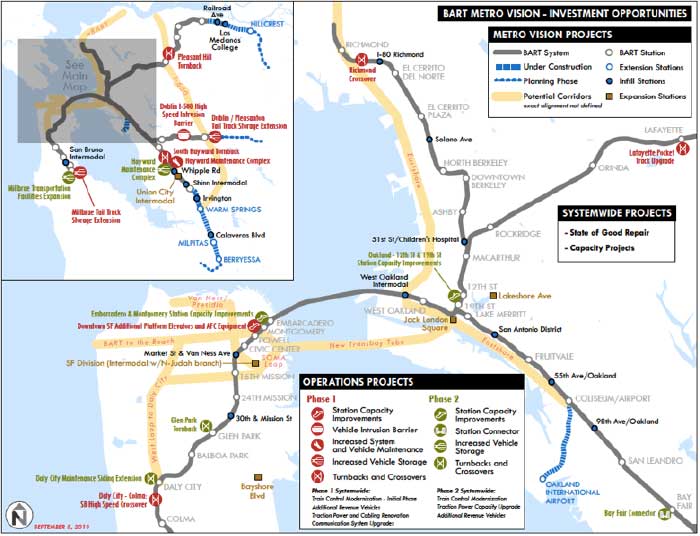Over the past few weeks, BART and Los Angeles’ Metro have each made big headlines, albeit for very different reasons. In the Bay Area, BART’s ongoing mechanical problems are the latest reminder of the system’s poor state of repair and constrained capacity. BART leaders have highlighted the need for reinvestment in the system via a possible $3.5 billion infrastructure bond for the November 2016 ballot. Meanwhile, in Los Angeles, leaders at Metro unveiled a proposal for a massive $120 billion sales tax measure to continue significant transit expansions in the region. While there are few comparable features between the two measures (Metro’s measure spans 50 years, and Los Angeles and Metro are much larger and located within a single county), their contrasting goals speak to a broader shortcoming of Bay Area transit planning: the lost ability to think big at solving regional problems.
BART’s infrastructure bond is a much needed measure to stop the system from falling apart – most of BART’s infrastructure is at the end of its useful life, and significant gains in reliability and core capacity could be realized by an influx of capital. However, BART’s bond will, at best, help the agency do a better job of meeting existing ridership demand; the measure misses an opportunity to deliver something new. While demand for new connections and capacity improvements is high, BART’s bond will not include any funding for new projects that were identified in its Metro Vision Plan like a second Transbay Tube, or complementary projects to enhance Transbay capacity like a contraflow bus-only lane.
Part of the challenge facing BART is it lacks the political clout to be a leader in solving the Bay Area’s transportation challenges. Transportation planning and funding in the Bay Area is decentralized between seven county agencies, 25+ transit operators, 100+ cities, and the Metropolitan Transportation Commission (MTC), so no single agency provides regional leadership. Moreover, regional coordination between these agencies is lacking as “me first” planning dominates. Transportation leaders often advocate for outward transit expansion projects which expand coverage as opposed to core capacity projects which maximize ridership. For example, Alameda County’s Measure BB, passed in 2014, included $400 million in funding for BART to Livermore, yet no funding for enhanced Transbay capacity. While MTC is supposed to provide regional leadership to balance local interests, its board is comprised of many of the same commissioners who advocate “me-first” projects on their respective agency commissions. As a result, BART has taken a surprisingly reduced role in deciding the projects that it plans and builds, and is in an awkward position when it comes to pushing forward new improvements.
BART needs money now and cannot afford to wait for a multi-county, state, or federal funding measure to solve its most-pressing problems. Yet by expending its political capital for a challenging measure that provides little vision and may not even cover the extent of its existing maintenance backlog, BART risks further frustrating and fatiguing voters. Multi-county ballot measures are tough to pass and don’t come along very often: hopefully BART can find the right balance between a realistic, achievable bond measure and one that provides a vision for how “our reality” will get better.


